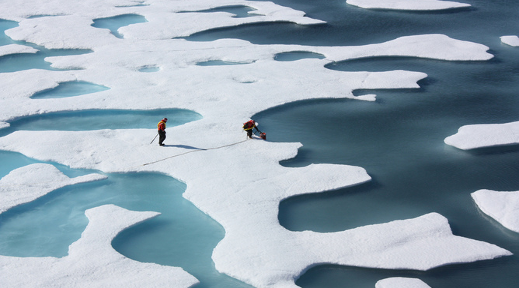When comparing global temperatures estimated from observations with climate model simulations it is necessary to compare ‘apples with apples’. Previous posts have discussed the issues of incomplete observational data, but a new paper by Cowtan et al. quantifies the influence of different observational data types. Continue reading An apples to apples comparison of global temperatures
Category Archives: GCMs
How not to use daily CMIP5 data for impact studies
A new paper out this week in PLOS Biology uses some CMIP5 simulations of daily mean surface air temperature as part of a larger analysis on the change to future plant growing days. The description of the analysis suggests they have not used the simulations appropriately to arrive at their conclusions. Here I highlight a couple of possible pitfalls in using such data in impact studies. Continue reading How not to use daily CMIP5 data for impact studies
Hiatus delays unprecedented warming rates
Current global temperatures are often discussed in terms of their unprecedented nature when compared to the last few thousand years. An interesting paper in Nature Climate Change by Steven J Smith and colleagues examines the rate of warming projected by the CMIP5 ensemble and suggests that the rate of warming is unprecedented also. However, we note here that their projections are not constrained by the current observations which do not show such strong warming rates at present, and are unlikely to do so in the next few years. Continue reading Hiatus delays unprecedented warming rates
Marotzke & Forster response
In a recent post on Climate Audit, Nic Lewis criticised Marotzke & Forster (2015, Nature) for applying circular logic to their arguments about forcing, feedbacks & global temperature trends. This is a guest post by Jochem Marotzke & Piers Forster replying to those criticisms. Continue reading Marotzke & Forster response

Arctic sea-ice decline erratic as expected
Imagine a ball bouncing down a bumpy hill. Gravity will ensure that the ball will head downwards. But, if the ball hits a bump at a certain angle it might move horizontally or even upwards for a time, before resuming its inevitable downward trajectory. This bouncing ball is an analogy for the behaviour of Arctic sea-ice.
Post based on Swart et al., Nature Climate Change, or see a less technical summary. Continue reading Arctic sea-ice decline erratic as expected
The slowdown zoo
Investigations into the recent observed slower rate of global warming have largely been focussed on variability in the Pacific basin. Climate models also show similar slowdowns focussed in the Pacific (e.g. Meehl et al. 2011).
But, is this the only type of simulated slowdown? How different can regional patterns of temperature change be for the same global change? Continue reading The slowdown zoo
Earth's energy imbalance
Global surface air temperatures have risen less rapidly over the past 15 years than the previous few decades. The causes of this ‘hiatus’ have been much debated. However, just considering surface temperatures does not tell the whole story – a new analysis using satellite & ocean observations confirms that the Earth is still gaining energy overall. Continue reading Earth's energy imbalance
Wet get drier (eventually)?
A prevailing paradigm of how rainfall patterns will change on a warming Earth is that the hydrological cycle strengthens causing wet regions to get wetter and dry regions to get drier.
However, this is not always the case: Hawkins, Joshi & Frame (2014) highlight one particular effect – the movement of the Inter-Tropical Convergence Zone (ITCZ) – as a key long-term driver of rainfall changes that do not follow this ‘wet get wetter’ paradigm. Continue reading Wet get drier (eventually)?